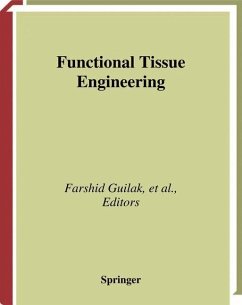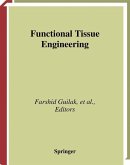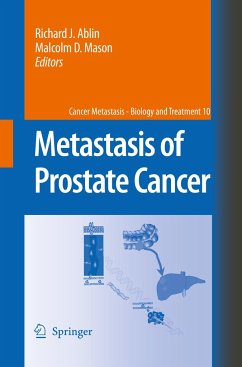The goal of tissue engineering is to repair or replace tissues and organs by delivering implanted cells, scaffolds, DNA, proteins, and/or protein fragments at surgery. Tissue engineering merges aspects of engineering and biology, and many rapid achievements in this field have arisen in part from significant advances in cell and molecular biology.
Functional Tissue Engineering addresses the key issues in repairing and replacing load-bearing structures effectively. What are the thresholds of force, stress, and strain that normal tissues transmit or encounter? What are the mechanical properties of these tissues when subjected to expected in vivo stresses and strains, as well as under failure conditions? Do tissue engineered repairs and replacements need to exactly duplicate the structure and function of the normal tissue or organ? When developing these implants in culture, how do physical factors such as mechanical stress regulate cell behavior in bioreactors as compared to signals experienced in vivo? And finally, can tissue engineers mechanically stimulate these implants before surgery to produce a better repair outcome?
Chapters written by well-known researchers discuss these matters and provide guidelines and a summary of the current state of technology.
Tissue engineering is an exciting new field at the interface of engineering and - ology that uses implanted cells, scaffolds, DNA, proteins, protein fragments, and inductive molecules to repair or replace injured or diseased tissues and organs. Tremendous progress in biological and biomaterial aspects of this field have been accomplished to date, and several engineered tissues are now being used clinically. However, tissue engineers face major challenges in repairing or repl- ing tissues that serve a predominantly biomechanical function. To meet this challenge, the United States National Committee on Biomech- ics in 1998 adopted a new paradigm termed functional tissue engineering (FTE) to emphasize the importance of biomechanical considerations in the design and - velopment of cell and matrix-based implants for soft and hard tissue repair. Functional tissue engineering represents a relevant and exciting new discipline in the field of tissue engineering. Since many tissues, such as those of the muscu- skeletal, cardiovascular, and dental systems, are accustomed to being mecha- cally challenged, tissue-engineered constructs used to replace these tissues after injury or disease must certainly do the same. Of course, tissue engineers must also attempt to return normal biological activity in order for the construct to truly - tegrate with the surrounding tissues. Thus, the term functional can have many meanings, such as restoration of metabolic function. The primary focus of this text is on the role of biomechanical function in tissue engineering.
Hinweis: Dieser Artikel kann nur an eine deutsche Lieferadresse ausgeliefert werden.
Functional Tissue Engineering addresses the key issues in repairing and replacing load-bearing structures effectively. What are the thresholds of force, stress, and strain that normal tissues transmit or encounter? What are the mechanical properties of these tissues when subjected to expected in vivo stresses and strains, as well as under failure conditions? Do tissue engineered repairs and replacements need to exactly duplicate the structure and function of the normal tissue or organ? When developing these implants in culture, how do physical factors such as mechanical stress regulate cell behavior in bioreactors as compared to signals experienced in vivo? And finally, can tissue engineers mechanically stimulate these implants before surgery to produce a better repair outcome?
Chapters written by well-known researchers discuss these matters and provide guidelines and a summary of the current state of technology.
Tissue engineering is an exciting new field at the interface of engineering and - ology that uses implanted cells, scaffolds, DNA, proteins, protein fragments, and inductive molecules to repair or replace injured or diseased tissues and organs. Tremendous progress in biological and biomaterial aspects of this field have been accomplished to date, and several engineered tissues are now being used clinically. However, tissue engineers face major challenges in repairing or repl- ing tissues that serve a predominantly biomechanical function. To meet this challenge, the United States National Committee on Biomech- ics in 1998 adopted a new paradigm termed functional tissue engineering (FTE) to emphasize the importance of biomechanical considerations in the design and - velopment of cell and matrix-based implants for soft and hard tissue repair. Functional tissue engineering represents a relevant and exciting new discipline in the field of tissue engineering. Since many tissues, such as those of the muscu- skeletal, cardiovascular, and dental systems, are accustomed to being mecha- cally challenged, tissue-engineered constructs used to replace these tissues after injury or disease must certainly do the same. Of course, tissue engineers must also attempt to return normal biological activity in order for the construct to truly - tegrate with the surrounding tissues. Thus, the term functional can have many meanings, such as restoration of metabolic function. The primary focus of this text is on the role of biomechanical function in tissue engineering.
Hinweis: Dieser Artikel kann nur an eine deutsche Lieferadresse ausgeliefert werden.
From the reviews:
"Functional Tissue Engineering is a useful compilation of research by contributors involved in developing tissues ... . It is not easy to extract a decent book from a conference, but the editors have done a very good job ... . it will be an invaluable source for those starting a PhD ... . I recommend it to those embarking on or already involved in engineering structural tissues. ... The chapters are well written ... . The book is clearly focused to encompass practical issues, such as the need to create appropriate biomechanical environments ... ." (Sheila MacNeil, Materials Today, July/August, 2005)
"Functional Tissue Engineering is a useful compilation of research by contributors involved in developing tissues ... . It is not easy to extract a decent book from a conference, but the editors have done a very good job ... . it will be an invaluable source for those starting a PhD ... . I recommend it to those embarking on or already involved in engineering structural tissues. ... The chapters are well written ... . The book is clearly focused to encompass practical issues, such as the need to create appropriate biomechanical environments ... ." (Sheila MacNeil, Materials Today, July/August, 2005)







